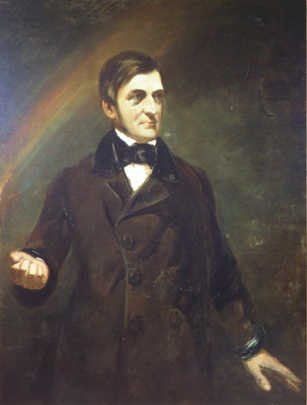 |
THE SCOTT PORTRAIT
79. David Scott. Ralph Waldo Emerson, 1848.
Oil on panel. Presented by Ebenezer Rockwood Hoar, Elizabeth Hoar,
and Reuben N. Rice, 1873.
This oil portrait of Emerson was painted by Scottish engraver and artist David Scott (1806-1849) in 1848, during Emerson’s second visit abroad. At the time, Emerson already had a following in Britain as well as in America. Scott—an admirer of Emerson’s writings—met him at a dinner party. Although the artist preferred classical and epic subjects to portraits, he was eager to paint Emerson and invited him to breakfast the following day. Emerson sat several times for Scott at his studio on the outskirts of Edinburgh. He described Scott as “a sort of Bronson Alcott with easel and brushes, a sincere great man, grave, silent, contemplative, and plain.” Scott found Emerson as a sitter not quite what he had anticipated. He thought Emerson’s appearance “severe, and dry, and hard,” that Emerson was “guarded and cold” at times. It was in conversation, Scott discovered, that the personality of the man—his simplicity, directness, kindness, and truthfulness—expressed itself. Scott depicted Emerson in the lecture stance, in the act of communication. He included one of Emerson’s characteristic physical traits—the clenching of one hand into a fist while lecturing. Scott also employed symbolism to convey something of Emerson’s philosophy. He suggested Transcendental optimism through the rainbow in the upper left corner of the painting. Emerson’s son Edward did not particularly like the Scott portrait of his father. But, as his comments in The Centenary of the Birth of Ralph Waldo Emerson (1903) reveal, he responded to the symbol of the rainbow: “ … in the pictures of the good men and women who have been canonized, they are represented with some emblem,—a book or a wheel or a cross or a sword, as an attribute. David Scott, the Edinburgh painter, has this one merit in that wooden picture that he made of my father, in that he recognized that my father stood for Hope, and he put the rainbow in the background—the symbol of hope.” David Scott died at forty-three, the year after he painted this portrait. Twenty years later, Scott’s brother William sent the piece to the United States to sell it. The painting received a mixed response here. Some close to Emerson—Lidian and Bronson Alcott, for example—thought it a good likeness. Others didn’t care for its darkness and for the stiffness of the figure. Emerson declined to buy it, as did Harvard. Finally, the founding of the Concord Free Public Library provided the motivation for Judge Hoar, his sister Elizabeth, and Reuben Rice to purchase it as a gift in recognition of Emerson’s importance to the library and to the community of Concord.
No image in this online display may be reproduced in any form, including electronic, without permission from the Curator of Special Collections of the Concord Free Public Library.
Next Entry - Back to Section VIII Contents Listing - Back to Exhibition Introduction - Back to Exhibition Table of Contents |